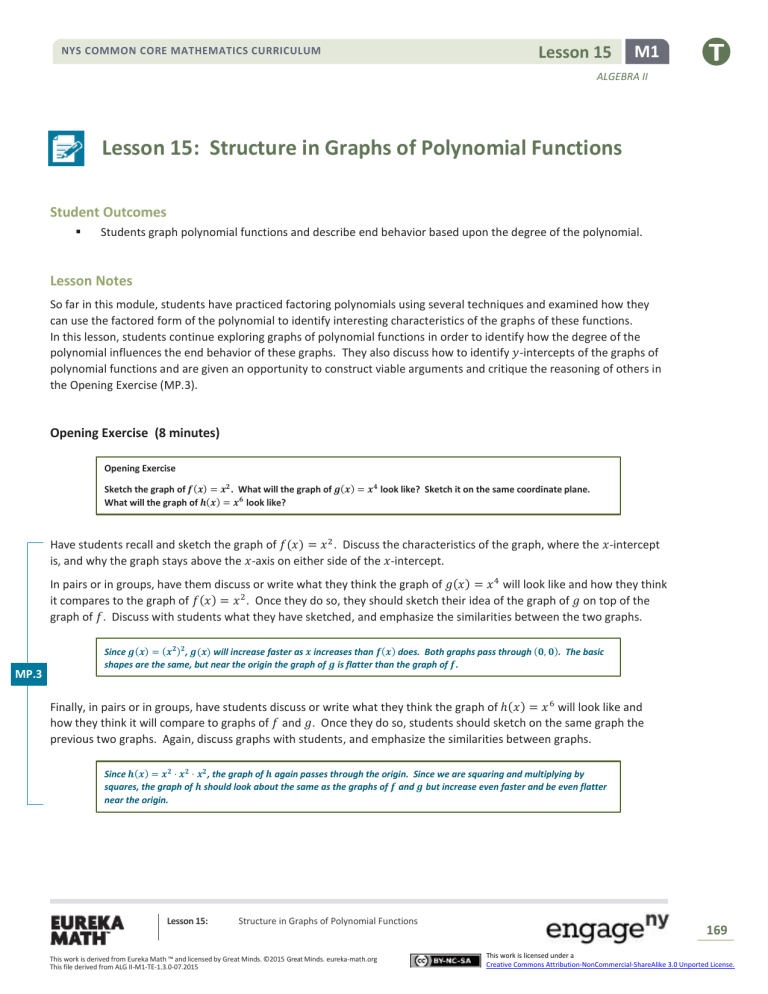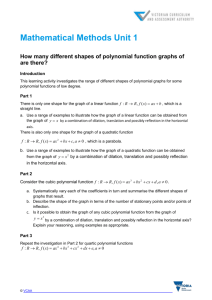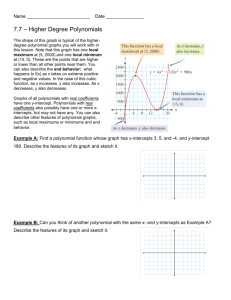Lesson 15: Structure in Graphs of Polynomial Functions

NYS COMMON CORE MATHEMATICS CURRICULUM
150
Lesson 15 M1
ALGEBRA II
Lesson 15: Structure in Graphs of Polynomial Functions
Student Outcomes
Students graph polynomial functions and describe end behavior based upon the degree of the polynomial.
Lesson Notes
So far in this module, students have practiced factoring polynomials using several techniques and examined how they can use the factored form of the polynomial to identify interesting characteristics of the graphs of these functions.
In this lesson, students continue exploring graphs of polynomial functions in order to identify how the degree of the polynomial influences the end behavior of these graphs. They also discuss how to identify 𝑦 -intercepts of the graphs of polynomial functions and are given an opportunity to construct viable arguments and critique the reasoning of others in the Opening Exercise (MP.3).
Opening Exercise (8 minutes)
Opening Exercise
Sketch the graph of 𝒇(𝒙) = 𝒙 𝟐 . What will the graph of 𝒈(𝒙) = 𝒙 𝟒 look like? Sketch it on the same coordinate plane.
What will the graph of 𝒉(𝒙) = 𝒙 𝟔 look like?
Have students recall and sketch the graph of 𝑓(𝑥) = 𝑥 2 . Discuss the characteristics of the graph, where the 𝑥 -intercept is, and why the graph stays above the 𝑥 -axis on either side of the 𝑥 -intercept.
In pairs or in groups, have them discuss or write what they think the graph of 𝑔(𝑥) = 𝑥 4
will look like and how they think it compares to the graph of 𝑓(𝑥) = 𝑥 2 . Once they do so, they should sketch their idea of the graph of 𝑔 on top of the graph of 𝑓 . Discuss with students what they have sketched, and emphasize the similarities between the two graphs.
Since 𝒈(𝒙) = (𝒙 𝟐 ) 𝟐 , 𝒈(𝒙) will increase faster as 𝒙 increases than 𝒇(𝒙) does. Both graphs pass through (𝟎, 𝟎) . The basic shapes are the same, but near the origin the graph of 𝒈 is flatter than the graph of 𝒇 .
MP.3
Finally, in pairs or in groups, have students discuss or write what they think the graph of ℎ(𝑥) = 𝑥 6 will look like and how they think it will compare to graphs of 𝑓 and 𝑔 . Once they do so, students should sketch on the same graph the previous two graphs. Again, discuss graphs with students, and emphasize the similarities between graphs.
Since 𝒉(𝒙) = 𝒙 𝟐 ⋅ 𝒙 𝟐 ⋅ 𝒙 𝟐 , the graph of 𝒉 again passes through the origin. Since we are squaring and multiplying by squares, the graph of 𝒉 should look about the same as the graphs of 𝒇 and 𝒈 but increase even faster and be even flatter near the origin.
Lesson 15: Structure in Graphs of Polynomial Functions
This work is derived from Eureka Math ™ and licensed by Great Minds. ©2015 Great Minds. eureka-math.org
This file derived from ALG II-M1-TE-1.3.0-07.2015
169
This work is licensed under a
Creative Commons Attribution-NonCommercial-ShareAlike 3.0 Unported License.
NYS COMMON CORE MATHEMATICS CURRICULUM Lesson 15
Using a graphing utility, have students graph all three functions simultaneously to confirm their sketches.
M1
ALGEBRA II
Discussion (5 minutes)
Use the graphs from the Opening Exercise to frame the following discussion about end behavior.
Ask students to compare and describe the behavior of the value 𝑓(𝑥) as the absolute value of 𝑥 increases without bound. Introduce the term end behavior as a way to talk about the function and what happens to its graph beyond the bounded region of the coordinate plane that is drawn on paper. That is, the end behavior is a way to describe what happens to the function as 𝑥 approaches positive and negative infinity without having to draw the graph.
Note to teacher: It is important to note that end behavior cannot be given a precise mathematical definition until the concept of a limit is introduced in calculus. To get around this difficulty, most high school textbooks draw pictures and state things like, “As 𝑥 → ∞ , 𝑓(𝑥) → ∞ .” We do this also, but it is important to carefully describe to students the meaning of the phrase, “As 𝑥 approaches positive infinity,” before using the phrase (or its symbol version) to describe end
behavior. That is because the phrase appears to mean that the symbol 𝑥 is literally “moving along the number line to the right.” Not true! Recall that a variable is just a placeholder for which a number can be substituted (think of a blank or box used in Grade 2 equations) and, therefore, does not actually move or vary.
The phrase, “As 𝑥 → ∞ ,” can be profitably described as a process by which the user of the phrase thinks of repeatedly substituting larger and larger positive numbers in for 𝑥 , each time performing whatever calculation is required by the problem for that number (which in this lesson is finding the value of the function).
This is how mathematicians often use the phrase even though the precise definition of limit removes any need to think of a limit as a process.
E ND BEHAVIOR (description): Let 𝑓 be a function whose domain and range are subsets of the real numbers.
The end behavior of a function 𝑓 is a description of what happens to the values of the function
as 𝑥 approaches positive infinity, and
as 𝑥 approaches negative infinity.
Lesson 15: Structure in Graphs of Polynomial Functions
This work is derived from Eureka Math ™ and licensed by Great Minds. ©2015 Great Minds. eureka-math.org
This file derived from ALG II-M1-TE-1.3.0-07.2015
170
This work is licensed under a
Creative Commons Attribution-NonCommercial-ShareAlike 3.0 Unported License.
NYS COMMON CORE MATHEMATICS CURRICULUM
Help students understand the description of end behavior using the following picture.
Lesson 15 M1
ALGEBRA II 𝑓(𝑥) → −∞ 𝑥 → −∞
Graph of 𝑦 = 𝑓(𝑥) 𝑥 → ∞ 𝑓(𝑥) → ∞
As 𝑥 → −∞ , 𝑓(𝑥) → −∞
As 𝑥 → ∞ , 𝑓(𝑥) → ∞
Ask students to make a generalization about the end behavior of polynomials of even degree in writing individually or with a partner. They should conclude that an even degree polynomial function has the same end behavior as 𝑥 → ∞ and as 𝑥 → −∞ . After students have generalized the end behavior, have them create their own graphic organizer like the following.
Lesson 15: Structure in Graphs of Polynomial Functions
This work is derived from Eureka Math ™ and licensed by Great Minds. ©2015 Great Minds. eureka-math.org
This file derived from ALG II-M1-TE-1.3.0-07.2015
171
This work is licensed under a
Creative Commons Attribution-NonCommercial-ShareAlike 3.0 Unported License.
NYS COMMON CORE MATHEMATICS CURRICULUM
Even-Degree 𝑓(𝑥) = 𝑥 2 𝑓(𝑥) = −𝑥 2
As 𝑥 → ∞ , 𝑓(𝑥) → ∞
As 𝑥 → −∞ , 𝑓(𝑥) → ∞
As 𝑥 → ∞ , 𝑓(𝑥) → −∞
As 𝑥 → −∞ , 𝑓(𝑥) → −∞
Lesson 15 M1
ALGEBRA II
If students suspect that end behavior of a polynomial function with even degree will always increase, then suggest examining the graphs of 𝑓(𝑥) = 1 − 𝑥 2
and 𝑔(𝑥) = −𝑥 4
.
Example 1 (8 minutes)
Students are now going to look at a new set of functions but ask similar questions to those asked in the Opening
Exercise.
Example 1
Sketch the graph of 𝒇(𝒙) = 𝒙 𝟑 . What will the graph of 𝒈(𝒙) = 𝒙 𝟓 look like? Sketch this on the same coordinate plane.
What will the graph of 𝒉(𝒙) = 𝒙 𝟕 look like? Sketch this on the same coordinate plane.
Have students recall and sketch the graph of 𝑓(𝑥) = 𝑥 3
. Discuss the characteristics of the graph, where the 𝑥 -intercept is, and why the graph is above the 𝑥 -axis for 𝑥 > 0 and below the 𝑥 -axis for 𝑥 < 0 .
MP.3
In pairs or in groups, have students discuss or write what they think the graph of 𝑔(𝑥) = 𝑥 5 will look like and how it will relate to the graph of 𝑓(𝑥) = 𝑥 3
. They should sketch their results on top of the original graph of 𝑓 . Discuss with students what they have sketched, and emphasize the similarities to the graph of 𝑓(𝑥) = 𝑥 3 .
Finally, in pairs or in groups, have students discuss or write what they think the graph of ℎ(𝑥) = 𝑥 7 will look like and how it will relate to the graphs of 𝑓 and 𝑔 . They should sketch on the same graph they used with the previous two graphs. Again, discuss the graphs with students, and emphasize the similarities between graphs.
Lesson 15: Structure in Graphs of Polynomial Functions
This work is derived from Eureka Math ™ and licensed by Great Minds. ©2015 Great Minds. eureka-math.org
This file derived from ALG II-M1-TE-1.3.0-07.2015
172
This work is licensed under a
Creative Commons Attribution-NonCommercial-ShareAlike 3.0 Unported License.
NYS COMMON CORE MATHEMATICS CURRICULUM Lesson 15
Using a graphing utility, have students graph all three functions simultaneously to confirm their sketches.
M1
ALGEBRA II
Ask students to compare and describe the behavior of the value of 𝑓(𝑥) as the absolute value of 𝑥 increases without bound. Guide them to use the terminology of the end behavior of the function.
Ask students to make a generalization about the end behavior of polynomials of odd degree individually or with a partner. After students have generalized the end behavior, have them create their own graphic organizer like the following.
Odd-Degree
As 𝑥 → ∞ , 𝑓(𝑥) → ∞
As 𝑥 → −∞ , 𝑓(𝑥) → −∞ 𝑓(𝑥) = 𝑥 3
As 𝑥 → ∞ , 𝑓(𝑥) → −∞
As 𝑥 → −∞ , 𝑓(𝑥) → ∞ 𝑓(𝑥) = −𝑥 3
Lesson 15: Structure in Graphs of Polynomial Functions
This work is derived from Eureka Math ™ and licensed by Great Minds. ©2015 Great Minds. eureka-math.org
This file derived from ALG II-M1-TE-1.3.0-07.2015
173
This work is licensed under a
Creative Commons Attribution-NonCommercial-ShareAlike 3.0 Unported License.
MP.8
NYS COMMON CORE MATHEMATICS CURRICULUM Lesson 15 M1
ALGEBRA II
If students suspect that polynomial functions with odd degree always have the value of the function increase as 𝑥 increases, then suggest examining a function with a negative leading coefficient, such as 𝑓(𝑥) = 4 − 𝑥 or 𝑔(𝑥) = −𝑥 3 .
How do these graphs differ from those in the Opening Exercise? Why are they different?
Students may talk about how the Opening Exercise graphs stay above the 𝑥 -axis while in this example the graphs cut through the 𝑥 -axis. Guide students as necessary to concluding that the end behavior of even-degree polynomial functions is that both ends both approach positive infinity or both approach negative infinity while the end behavior of odd-degree polynomial functions is that the behavior as 𝑥 → ∞ is opposite of the behavior as 𝑥 → −∞ .
Exercise 1 (8 minutes)
Keeping the results of the examples above in mind, have students work with partners or in groups to answer the following questions.
Exercise 1 a.
Consider the following function, 𝒇(𝒙) = 𝟐𝒙 𝟒 + 𝒙 𝟑 − 𝒙 𝟐 + 𝟓𝒙 + 𝟑 , with a mixture of odd and even degree terms. Predict whether its end behavior will be like the functions in the Opening Exercise or more like the functions from Example 1. Graph the function 𝒇 using a graphing utility to check your prediction.
Students see that this function acts more like the even-degree monomial functions from the Opening Exercise.
b.
Consider the following function, 𝒇(𝒙) = 𝟐𝒙 𝟓 − 𝒙 𝟒 − 𝟐𝒙 𝟑 + 𝟒𝒙 𝟐 + 𝒙 + 𝟑 , with a mixture of odd and even degree terms. Predict whether its end behavior will be like the functions in the Opening Exercise or more like the functions from Example 1. Graph the function 𝒇 using a graphing utility to check your prediction.
Students see that this function acts more like odd-degree monomial functions from Example 1. They can draw a conclusion such as that the function behaves like the highest degree term. c.
Thinking back to our discussion of 𝒙 -intercepts of graphs of polynomial functions from the previous lesson, sketch a graph of an even-degree polynomial function that has no 𝒙 -intercepts.
Students may draw the graph of a quadratic function that stays above the 𝒙 -axis such as the graph of 𝒇(𝒙) = 𝒙 𝟐 + 𝟏 .
d.
Similarly, can you sketch a graph of an odd-degree polynomial function with no 𝒙 -intercepts?
Have students work in pairs or groups and discover that because of the “cut through” nature of graphs of odd-degree polynomial function there is always an 𝒙 -intercept.
Conclusion: Graphs of odd-powered polynomial functions always have an 𝒙 -intercept, which means that odd-degree polynomial functions always have at least one zero (or root) and that polynomial functions of odd-degree always have opposite end behaviors as 𝒙 → ∞ and 𝒙 → −∞ .
Have students conclude that the graphs of odd-degree polynomial functions always have at least one 𝑥 -intercept and so the functions always have at least one zero. The graphs of even-degree polynomial functions may or may not have 𝑥 -intercepts.
Lesson 15: Structure in Graphs of Polynomial Functions
This work is derived from Eureka Math ™ and licensed by Great Minds. ©2015 Great Minds. eureka-math.org
This file derived from ALG II-M1-TE-1.3.0-07.2015
174
This work is licensed under a
Creative Commons Attribution-NonCommercial-ShareAlike 3.0 Unported License.
NYS COMMON CORE MATHEMATICS CURRICULUM
Exercise 2 (8 minutes)
Lesson 15 M1
ALGEBRA II
In this exercise, students use what they learned today about end behavior to determine whether or not the polynomial function used to model the data has an even or odd degree.
Exercise 2
The Center for Transportation Analysis (CTA) studies all aspects of transportation in the United States, from energy and environmental concerns to safety and security challenges. A 1997 study compiled the following data of the fuel economy in miles per gallon (mpg) of a car or light truck at various speeds measured in miles per hour (mph). The data are compiled in the table below.
Fuel Economy by Speed
Speed (mph)
𝟏𝟓
𝟐𝟎
𝟐𝟓
𝟑𝟎
𝟑𝟓
𝟒𝟎
𝟒𝟓
𝟓𝟎
𝟓𝟓
𝟔𝟎
𝟔𝟓
𝟕𝟎
𝟕𝟓
Fuel Economy (mpg)
𝟐𝟒. 𝟒
𝟐𝟕. 𝟗
𝟑𝟎. 𝟓
𝟑𝟏. 𝟕
𝟑𝟏. 𝟐
𝟑𝟏. 𝟎
𝟑𝟏. 𝟔
𝟑𝟐. 𝟒
𝟑𝟐. 𝟒
𝟑𝟏. 𝟒
𝟐𝟗. 𝟐
𝟐𝟔. 𝟖
𝟐𝟒. 𝟖
Source: Transportation Energy Data Book, Table 4.28. http://cta.ornl.gov/data/chapter4.shtml a.
Plot the data using a graphing utility. Which variable is the independent variable?
Speed is the independent variable. b.
This data can be modeled by a polynomial function. Determine if the function that models the data would have an even or odd degree.
It seems we could model this data by an even-degree polynomial function. c.
Is the leading coefficient of the polynomial that can be used to model this data positive or negative?
The leading coefficient would be negative since the end behavior of this function is to approach negative infinity on both sides. d.
List two possible reasons the data might have the shape that it does.
Possible responses: Fuel economy improves up to a certain speed, but then wind resistance at higher speeds reduces fuel economy; the increased gas needed to go higher speeds reduces fuel economy.
Lesson 15: Structure in Graphs of Polynomial Functions
This work is derived from Eureka Math ™ and licensed by Great Minds. ©2015 Great Minds. eureka-math.org
This file derived from ALG II-M1-TE-1.3.0-07.2015
175
This work is licensed under a
Creative Commons Attribution-NonCommercial-ShareAlike 3.0 Unported License.
NYS COMMON CORE MATHEMATICS CURRICULUM
Closing (3 minutes)
Lesson 15 M1
ALGEBRA II
In this lesson, students explored the characteristics of the graphs of polynomial functions of even and odd-degree. Graphs of even-degree polynomials demonstrate the same end behavior as 𝑥 → ∞ as it does as 𝑥 → −∞ , while graphs of odd-degree polynomials demonstrate opposite end behavior as 𝑥 → ∞ as it does as 𝑥 → −∞ . Because of this fact, graphs of odd-degree polynomial functions always intersect the 𝑥 -axis; therefore, odd-degree polynomial functions have at least one zero or root.
Students also learned that it is the highest degree term of the polynomial that determines if the graph exhibits odd-degree end behavior or even-degree end behavior. This makes sense because the highest degree term of a polynomial determines the degree of the polynomial.
Have students summarize the lesson either with a graphic organizer or a written summary. A graphic organizer is included below.
Even-Degree Odd-Degree
As 𝑥 → ∞ , 𝑓(𝑥) → ∞
As 𝑥 → −∞ , 𝑓(𝑥) → ∞
As 𝑥 → ∞ , 𝑓(𝑥) → −∞
As 𝑥 → −∞ , 𝑓(𝑥) → −∞
As 𝑥 → ∞ , 𝑓(𝑥) → ∞
As 𝑥 → −∞ , 𝑓(𝑥) → −∞
As 𝑥 → ∞ , 𝑓(𝑥) → −∞
As 𝑥 → −∞ , 𝑓(𝑥) → ∞
Relevant Vocabulary
E VEN FUNCTION : Let 𝒇 be a function whose domain and range is a subset of the real numbers. The function 𝒇 is called even if the equation 𝒇(𝒙) = 𝒇(−𝒙) is true for every number 𝒙 in the domain.
Even-degree polynomial functions are sometimes even functions, like 𝒇(𝒙) = 𝒙 𝟏𝟎 , and sometimes not, like 𝒈(𝒙) = 𝒙 𝟐 − 𝒙 .
O DD FUNCTION : Let 𝒇 be a function whose domain and range is a subset of the real numbers. The function 𝒇 is called odd if the equation 𝒇(−𝒙) = −𝒇(𝒙) is true for every number 𝒙 in the domain.
Odd-degree polynomial functions are sometimes odd functions, like 𝒇(𝒙) = 𝒙 𝟏𝟏 , and sometimes not, like 𝒉(𝒙) = 𝒙 𝟑 − 𝒙 𝟐 .
Exit Ticket (5 minutes)
Lesson 15: Structure in Graphs of Polynomial Functions
This work is derived from Eureka Math ™ and licensed by Great Minds. ©2015 Great Minds. eureka-math.org
This file derived from ALG II-M1-TE-1.3.0-07.2015
176
This work is licensed under a
Creative Commons Attribution-NonCommercial-ShareAlike 3.0 Unported License.
NYS COMMON CORE MATHEMATICS CURRICULUM
Name
Lesson 15 M1
ALGEBRA II
Date
Lesson 15: Structure in Graphs of Polynomial Functions
Exit Ticket
Without using a graphing utility, match each graph below in column 1 with the function in column 2 that it represents. a.
1.
𝑦 = 3𝑥 3 b.
2.
𝑦 =
1
2 𝑥 2 c.
3.
𝑦 = 𝑥 3 − 8 d.
4.
𝑦 = 𝑥 4 − 𝑥 3 + 4𝑥 + 2 e.
5.
𝑦 = 3𝑥 5 − 𝑥 3 + 4𝑥 + 2
Lesson 15: Structure in Graphs of Polynomial Functions
This work is derived from Eureka Math ™ and licensed by Great Minds. ©2015 Great Minds. eureka-math.org
This file derived from ALG II-M1-TE-1.3.0-07.2015
177
This work is licensed under a
Creative Commons Attribution-NonCommercial-ShareAlike 3.0 Unported License.
NYS COMMON CORE MATHEMATICS CURRICULUM
Exit Ticket Sample Solutions
Lesson 15
Without using a graphing utility, match each graph below in column 1 with the function in column 2 that it represents.
M1
ALGEBRA II a.
1.
𝒚 = 𝟑𝒙 𝟑 b. c.
2.
𝒚 =
𝟏
𝟐 𝒙 𝟐
3.
𝒚 = 𝒙 𝟑 − 𝟖 d. e.
4.
𝒚 = 𝒙 𝟒 − 𝒙 𝟑 + 𝟒𝒙 + 𝟐
5.
𝒚 = 𝟑𝒙 𝟓 − 𝒙 𝟑 + 𝟒𝒙 + 𝟐
Lesson 15: Structure in Graphs of Polynomial Functions
This work is derived from Eureka Math ™ and licensed by Great Minds. ©2015 Great Minds. eureka-math.org
This file derived from ALG II-M1-TE-1.3.0-07.2015
178
This work is licensed under a
Creative Commons Attribution-NonCommercial-ShareAlike 3.0 Unported License.
NYS COMMON CORE MATHEMATICS CURRICULUM
Problem Set Sample Solutions
Lesson 15 M1
ALGEBRA II
1.
Graph the functions from the Opening Exercise simultaneously using a graphing utility and zoom in at the origin. a.
At 𝒙 = 𝟎. 𝟓 , order the values of the functions from least to greatest.
At 𝒙 = 𝟎. 𝟓 , 𝒙 𝟔 < 𝒙 𝟒 < 𝒙 𝟐 . b.
At 𝒙 = 𝟐. 𝟓 , order the values of the functions from least to greatest.
At 𝒙 = 𝟐. 𝟓 , 𝒙 𝟐 < 𝒙 𝟒 < 𝒙 𝟔 . c.
Identify the 𝒙 -value(s) where the order reverses. Write a brief sentence on why you think this switch occurs.
At 𝒙 = 𝟏 and 𝒙 = −𝟏 , the values of the functions are equal. Students may write that when a number between 𝟎 and 𝟏 is taken to higher even powers, it gets smaller, and when a number greater than 𝟏 is taken to higher even powers, it gets larger, and when a negative number is raised to an even power it becomes positive. So for −𝟏 < 𝒙 < 𝟎 the behavior is the same as for 𝟎 < 𝒙 < 𝟏 .
2.
The National Agricultural Statistics Service (NASS) is an agency within the USDA that collects and analyzes data covering virtually every aspect of agriculture in the United States. The following table contains information on the amount (in tons) of the following vegetables produced in the U.S. from 1988–1994 for processing into canned, frozen, and packaged foods: lima beans, snap beans, beets, cabbage, sweet corn, cucumbers, green peas, spinach, and tomatoes.
Year
1988
1989
1990
1991
1992
1993
1994
Vegetable Production by Year
Vegetable Production (tons)
𝟏𝟏, 𝟑𝟗𝟑, 𝟑𝟐𝟎
𝟏𝟒, 𝟒𝟓𝟎, 𝟖𝟔𝟎
𝟏𝟓, 𝟒𝟒𝟒, 𝟗𝟕𝟎
𝟏𝟔, 𝟏𝟓𝟏, 𝟎𝟑𝟎
𝟏𝟒, 𝟐𝟑𝟔, 𝟑𝟐𝟎
𝟏𝟒, 𝟗𝟎𝟒, 𝟕𝟓𝟎
𝟏𝟖, 𝟑𝟏𝟑, 𝟏𝟓𝟎
Source: NASS Statistics of Vegetables and Melons, 1995, Table 191. http://www.nass.usda.gov/Publications/Ag_Statistics/1995-1996/agr95_4.pdf a.
Plot the data using a graphing utility. b.
Determine if the data display the characteristics of an odd- or even-degree polynomial function.
Looking at the end behavior, the data show the characteristics of an odd-degree polynomial function.
Lesson 15: Structure in Graphs of Polynomial Functions
This work is derived from Eureka Math ™ and licensed by Great Minds. ©2015 Great Minds. eureka-math.org
This file derived from ALG II-M1-TE-1.3.0-07.2015
179
This work is licensed under a
Creative Commons Attribution-NonCommercial-ShareAlike 3.0 Unported License.
NYS COMMON CORE MATHEMATICS CURRICULUM Lesson 15 c.
List two possible reasons the data might have such a shape.
Possible responses: Bad weather in 1992 and 1993; shifts in demand for fresh foods vs. processed.
3.
The U.S. Energy Information Administration (EIA) is responsible for collecting and analyzing information about energy production and use in the United States and for informing policy makers and the public about issues of energy, the economy, and the environment. The following table contains data from the EIA about natural gas consumption from 1950–2010, measured in millions of cubic feet.
M1
ALGEBRA II
1950
1955
1960
1965
1970
1975
1980
1985
1990
1995
2000
2005
2010
U.S. Natural Gas Consumption by Year
Year U.S. natural gas total consumption
(millions of cubic feet)
𝟓. 𝟕𝟕
𝟖. 𝟔𝟗
𝟏𝟏. 𝟗𝟕
𝟏𝟓. 𝟐𝟖
𝟐𝟏. 𝟏𝟒
𝟏𝟗. 𝟓𝟒
𝟏𝟗. 𝟖𝟖
𝟏𝟕. 𝟐𝟖
𝟏𝟗. 𝟏𝟕
𝟐𝟐. 𝟐𝟏
𝟐𝟑. 𝟑𝟑
𝟐𝟐. 𝟎𝟏
𝟐𝟒. 𝟎𝟗
Source: U.S. Energy Information Administration. http://www.eia.gov/dnav/ng/hist/n9140us2a.htm a.
Plot the data using a graphing utility. b.
Determine if the data display the characteristics of an odd- or even-degree polynomial function.
Looking at the end behavior, the data show the characteristics of an odd-degree polynomial function. c.
List two possible reasons the data might have such a shape.
Possible responses: changes in supply, new sources and technology created new supplies, weather may impact usage.
Lesson 15: Structure in Graphs of Polynomial Functions
This work is derived from Eureka Math ™ and licensed by Great Minds. ©2015 Great Minds. eureka-math.org
This file derived from ALG II-M1-TE-1.3.0-07.2015
180
This work is licensed under a
Creative Commons Attribution-NonCommercial-ShareAlike 3.0 Unported License.
NYS COMMON CORE MATHEMATICS CURRICULUM Lesson 15
4.
We use the term even function when a function 𝒇 satisfies the equation 𝒇(−𝒙) = 𝒇(𝒙) for every number 𝒙 in its domain. Consider the function 𝒇(𝒙) = −𝟑𝒙 𝟐 + 𝟕 . Note that the degree of the function is even, and each term is of an even degree (the constant term is degree 𝟎 ). a.
Graph the function using a graphing utility.
M1
ALGEBRA II b.
Does this graph display any symmetry?
Yes, it is symmetric about the 𝒚 -axis. c.
Evaluate 𝒇(−𝒙) . 𝒇(−𝒙) = −𝟑(−𝒙) 𝟐 + 𝟕 = −𝟑𝒙 𝟐 + 𝟕 d.
Is 𝒇 an even function? Explain how you know.
Yes, because 𝒇(−𝒙) = −𝟑𝒙 𝟐 + 𝟕 = 𝒇(𝒙) for all real values of 𝒙 .
5.
We use the term odd function when a function 𝒇 satisfies the equation 𝒇(−𝒙) = −𝒇(𝒙) for every number 𝒙 in its domain. Consider the function 𝒇(𝒙) = 𝟑𝒙 𝟑 − 𝟒𝒙 . The degree of the function is odd, and each term is of an odd degree. a.
Graph the function using a graphing utility. b.
Does this graph display any symmetry?
Yes, but not the same as in part (a). This graph is symmetric about the origin. We can see this because if the graph is rotated 𝟏𝟖𝟎° about the origin, it appears to be unchanged. c.
Evaluate 𝒇(−𝒙) . 𝒇(−𝒙) = 𝟑(−𝒙) 𝟑 − 𝟒(−𝒙) = −𝟑𝒙 𝟑 + 𝟒𝒙 d.
Is 𝒇 an odd function? Explain how you know.
Yes, we know because 𝒇(−𝒙) = −𝟑𝒙 𝟑 + 𝟒𝒙 = −(𝟑𝒙 𝟑 − 𝟒𝒙) = −𝒇(𝒙) for all real values of 𝒙 .
Lesson 15: Structure in Graphs of Polynomial Functions
This work is derived from Eureka Math ™ and licensed by Great Minds. ©2015 Great Minds. eureka-math.org
This file derived from ALG II-M1-TE-1.3.0-07.2015
181
This work is licensed under a
Creative Commons Attribution-NonCommercial-ShareAlike 3.0 Unported License.
NYS COMMON CORE MATHEMATICS CURRICULUM Lesson 15
6.
We have talked about 𝒙 -intercepts of the graph of a function in both this lesson and the previous one.
The 𝒙 -intercepts correspond to the zeros of the function. Consider the following examples of polynomial functions and their graphs to determine an easy way to find the 𝒚 -intercept of the graph of a polynomial function.
M1
ALGEBRA II 𝑓(𝑥) = 2𝑥 2 − 4𝑥 − 3 𝑓(𝑥) = 𝑥 3 + 3𝑥 2 − 𝑥 + 5 𝑓(𝑥) = 𝑥 4 − 2𝑥 3 − 𝑥 2 + 3𝑥 − 6
The 𝒚 -intercept is the value where the graph of a function 𝒇 intersects the 𝒚 -axis, if 𝟎 is in the domain of 𝒇 .
Therefore, for a function 𝒇 whose domain and range are a subset of the real numbers, the 𝒚 -intercept is 𝒇(𝟎) .
For polynomial functions, 𝒇(𝟎) is easy to determine—it is just the constant term when the polynomial function is written in standard form.
Lesson 15: Structure in Graphs of Polynomial Functions
This work is derived from Eureka Math ™ and licensed by Great Minds. ©2015 Great Minds. eureka-math.org
This file derived from ALG II-M1-TE-1.3.0-07.2015
182
This work is licensed under a
Creative Commons Attribution-NonCommercial-ShareAlike 3.0 Unported License.







